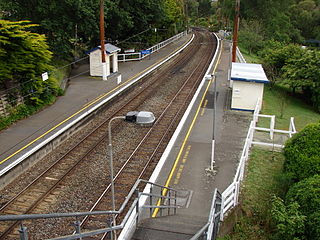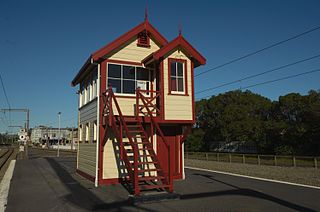
Public transport in the Wellington Region, branded under the name Metlink, is the public transport system serving Wellington and its surrounding region. It is the most used public transport system in New Zealand per capita, and consists of electric and diesel buses, suburban trains, ferries and a funicular. It also included trams until 1964, and trolleybuses until 2017.

The New Zealand DM/D class electric multiple unit were a type of electric multiple units used on the suburban rail network of Wellington, New Zealand. Formed of DM power cars and D trailer cars, the first units were ordered from English Electric in 1936 and introduced on 2 July 1938 operating the electrified Johnsonville Line service. Additional units were ordered in 1942 for the line, and in 1946 as the other Wellington suburban lines were to be electrified.

The New Zealand EM/ET class electric multiple units were used on suburban services in Wellington, New Zealand from 1982 to 2016. They were owned initially by the New Zealand Railways Corporation and finally by the Greater Wellington Regional Council (GWRC) and operated by Tranz Metro, part of national railway operator KiwiRail.

The Capital Connection is a long-distance commuter train operated by KiwiRail between Palmerston North and the capital city of Wellington on the North Island Main Trunk.

The Wairarapa Connection is a New Zealand interurban commuter rail service along the Wairarapa Line between Masterton, the largest town in the Wairarapa, and Wellington. It is operated by Wellington suburban operator Transdev under contract from the Greater Wellington Regional Council. It is a diesel-hauled carriage service, introduced by the New Zealand Railways Department in 1964 after passenger demand between Masterton to Wellington exceeded the capacity of the diesel railcars then used.

Metlink's Kapiti Line is the electrified southern portion of the North Island Main Trunk railway between New Zealand's capital city, Wellington, and Waikanae on the Kāpiti Coast, operated by Transdev Wellington on behalf of Greater Wellington Regional Council. Trains run frequently every day, with stops at 16 stations. Until 20 February 2011 it was known as the Paraparaumu Line.

Takapu Road railway station is on the suburban rail network of Wellington, New Zealand, on the Kapiti section of the North Island Main Trunk Railway (NIMT). It is double tracked with side platforms. It serves the suburbs of Redwood and Grenada North, and the rural Takapu Valley.

Tawa railway station, originally called Tawa Flat, is on the North Island Main Trunk Railway (NIMT) and is part of the suburban rail network of Wellington, New Zealand. It is double tracked with an island platform, and is 13.75 kilometres (8.54 mi) from Wellington railway station, the southern terminus of the NIMT. The station serves the suburb of Tawa.

Kenepuru railway station is on the North Island Main Trunk Railway (NIMT) in New Zealand, on Wellington's suburban rail network. It is double tracked with side platforms on a curved section of the line, 16.16 km from Wellington railway station, the southern terminus of the NIMT. The station serves the industrial suburb of Kenepuru and is within walking distance of Kenepuru Hospital.

The New Zealand FP/FT "Matangi" class is a class of electric multiple units used on the suburban rail network of New Zealand's capital city, Wellington. The class, consisting of an FP power car and an FT trailer car, operates services on all electrified lines of the network which comprise the Kapiti, Hutt Valley, Melling and Johnsonville lines. The units are owned by Greater Wellington Rail Ltd, a subsidiary of the Greater Wellington Regional Council (GWRC), and have been operated by Transdev Wellington under contract to the GWRC since 2016. They were previously operated by Tranz Metro, a former division of KiwiRail.

The New Zealand British Rail Mark 2 carriages were built by British Rail Engineering Limited for British Rail in the early 1970s. From the mid-1990s, 150 were exported to New Zealand. After being rebuilt, refurbished and re-gauged, they entered service with a variety of operators on New Zealand's railway network. The carriages generally replaced older NZR 56-foot carriages, some of which had been in use for almost 70 years.

Pukerua Bay railway station is located on the North Island Main Trunk Railway (NIMT) in Pukerua Bay, New Zealand and is part of the suburban rail network of Wellington. It is double tracked, has an island platform layout, and is 30.4 km from Wellington railway station, the southern terminus of the NIMT. It is one of two railway stations in Pukerua Bay, the other one at Muri being closed.
Plimmerton railway station is on the North Island Main Trunk Railway (NIMT) in Plimmerton, Porirua, New Zealand, and is part of Wellington's Metlink suburban rail network operated by Transdev Wellington. It is double tracked around a long island platform, with subway access from Steyne Avenue and Plimmerton Domain's Park and Ride to the north, and a controlled crossing to Steyne Avenue and Mainline Steam at the south end of the platform. Mainline Steam, a heritage steam train restorer and operator, is located in the former goods yard next to the station.

Paremata railway station on the Kapiti Line section of the North Island Main Trunk Railway (NIMT) in Paremata in the city of Porirua, New Zealand, is part of the Wellington Region's Metlink suburban rail network.

Mana railway station on the Kapiti Line section of the North Island Main Trunk Railway (NIMT) in the locality of Mana in the Paremata suburb of the city of Porirua, New Zealand is part of Wellington's Metlink suburban rail network.

Paekakariki railway station in Paekākāriki on the Kāpiti Coast, New Zealand, is an intermediate station on the Kapiti Line for Metlink's electric multiple unit commuter trains from Wellington. Paekākāriki was the terminal station of the commuter service from 1940 to 1983, when the service was extended to Paraparaumu, and to Waikanae in 2011.

Naenae railway station is a suburban railway station serving Naenae and Avalon in Lower Hutt, New Zealand. The station is located on the Hutt Valley section of the Wairarapa Line, 18.3 km (11.4 mi) north of Wellington. The station is served by Metlink's electric multiple unit trains of the "Matangi" FP class. Trains stopping at Naenae run to Wellington, Taitā and Upper Hutt.
Paraparaumu railway station in Paraparaumu on the Kāpiti Coast, New Zealand is an intermediate station on the Kapiti Line section of the North Island Main Trunk for Metlink's electric multiple unit commuter trains from Wellington. Paraparaumu was the northern terminal for Kapiti Line services from 7 May 1983 until 20 February 2011 when the electrification and Kapiti Line services were extended to Waikanae.
Waikanae railway station in Waikanae on the Kāpiti Coast, New Zealand, is the terminal station on the Kapiti Line for Metlink's electric multiple unit commuter trains from Wellington. The railway is part of the North Island Main Trunk line that connects Wellington and Auckland.

Transdev Wellington is the operator of Wellington's Metlink rail network in New Zealand. The entity is a partnership of Transdev Australasia and Hyundai Rotem, who were awarded the contract to operate and maintain the commuter rail system in December 2015 by the Greater Wellington Regional Council. The contract commenced on 3 July 2016, taking over from KiwiRail division Tranz Metro.



























